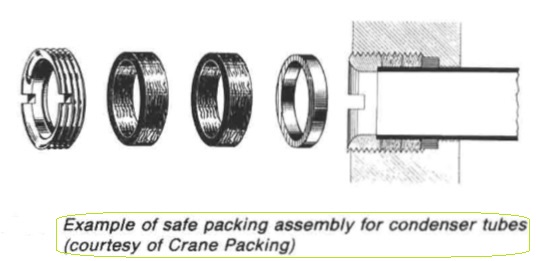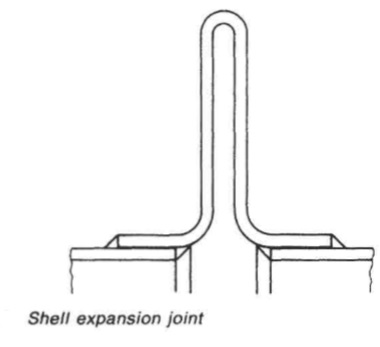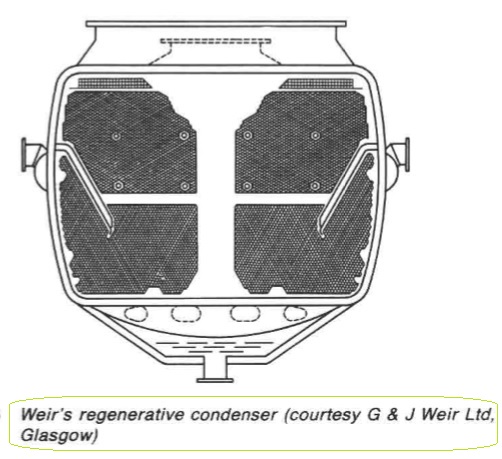
Figure 1 :Example of safe packing assembly for condenser tubes (courtesy of Crane Packing)
An expansion allowance (Figure 2), provided where tubes are expanded into tube plates at both ends, may take the form of a shell expansion joint. Tubes are prevented from sagging by a number of mild steel tube support plates. A baffle plate at the entrance to the steam space, prevents damage from the direct impact of steam on the tubes. Access doors are provided in the water box end covers of very large condensers for routine inspection and cleaning, with one or more manholes in the shell bottom for the same purpose.

Figure 2: Shell expansion joint
Corrosion by galvanic action is inhibited by zinc or mild steel sacrificial anodes or alternatively, impressed current protection may be used. Dezincification of brasses may be prevented by additives, such as 0.04% arsenic, to the alloy. Tube failure is likely to be caused by impingement, that is corrosion/erosion arising from entrained air in, or excessive speed of, circulating water. Failure could otherwise be from stress/corrosion cracking or dezincification of brass tubes. Defective tubes can be plugged temporarily.
The regenerative condenser
As it expands through a turbine, as much as possible of the available useful work is extracted from the steam by maintaining vacuum conditions in the condenser. Part of the function of the condenser is to condense the steam from the low pressure end of the turbine at as low a pressure as possible. The effective operation of a condenser requires that the sea water is colder than the saturation temperature of the exhaust steam and this means that undercooling will occur.

Figure 3: Weir's regenerative condenser (courtesy G & J Weir Ltd, Glasgow)
Any undercooling must be made good during the cycle which turns the feed water back to steam, and undercooling increases the temperature range through which the condensate, returning to the boiler, must be raised again before it boils off. To avoid this thermal loss, condensers are built with regenerative ability in that paths (Figure 3) are arranged between and below the tube banks for direct flow of part of the steam to the lower part of the condenser.
This steam then flows up between the tubes and meets the condensate from the main part of the exhaust, dripping from the tubes. The undercooled condensate falls through this steam atmosphere and heat transfer occurs, resulting in negligible undercooling in the final condensate.
The condensate, dripping from the tubes, may be below the saturation temperature corresponding to the vacuum, by as much as 5 deg C, initially. The de-aeration performance of a condenser is also related to undercooling in that the amount of gas, such as oxygen, that can remain in solution in a water droplet at below saturation temperature is dependent on the degree of undercooling.
Theoretically, if a water droplet is at the saturation temperature then no gas will remain in solution with it. One method of reducing the degree of undercooling when sea water temperature is low, is to recirculate a portion of the cooling water to enable the condenser to be worked at its design condition, whenever possible.
Summarized below various circulating systems for motorships, some of the basic procedure of heat exchangers & control of temperatures:
- Sea water circulation-systems
- Shell and tube heat exchangers for engine cooling water and lubricating oil cooling
- Plate type heat exchanger
- Details of charged air cooler
- Maintenance of heat exchangers
- Central cooling system & Scoop arrangement for motorships
- Circulating systems for steamships
- Closed feed system and feed heating for motor ships
- Marine condenser assembly
- Three stage air ejector with internal diffusers
- Pressure governor for motor ships
- Liquid ring pump- Nash rotary liquid ring pumps
- The Weir electro-feeder - a multi-stage centrifugal pump
- Feed water heaters for motor ships
- Devaporizer & turbo-feed pump
- Typical de-aerator & Cascade trays
The usual arrangement for motorships has been to have sea-water circulation of coolers for lubricating oil, piston cooling, jacket water, charge air, turbo-charger oil (if there are sleeve type bearings) and fuel valve cooling, plus direct sea-water cooling for air compressors and evaporators....
Shell and tube heat exchangers for engine cooling water and lubricating oil cooling have traditionally been circulated with sea water. The sea water is in contact with the inside of the tubes, tube plates and water boxes....
The obvious feature of plate type heat exchangers, is that they are easily opened for cleaning. The major advantage over tube type coolers, is that their higher efficiency is reflected in a smaller size for the same cooling capacity....
The charge air coolers fitted to reduce the temperature of air after the turbo-charger and before entry to the diesel engine cylinder, are provided with fins on the heat transfer surfaces to compensate for the relatively poor heat transfer properties of air....
The only attention that marine heat exchangers should require is to ensure that the heat transfer surfaces should remain substantially clean and flow passage generally clear of obstructions. Indcation that fouling has occured is given by a progressive increase in the temperature difference between the two fluids, and change of pressure....
The corrosion and other problems associated with salt water circulation systems can be minimized by using it for cooling central coolers through which fresh water from a closed general cooling circuit is passed. The salt water passes through only one set of pumps, valves and filters and a short length of piping.....
The main sea-water circulating system for a ship with main propulsion by steam turbine is similar to that of a motorship with a central cooling system. The difference is that the sea water passes through a ....
To ensure trouble-free operation of water-tube boilers the feed water must be of high quality with a minimal solid content and an absence of dissolved gases. Solids are deposited on the inside surfaces of steam generating tubes,....
A condenser is a vessel in which a vapour is deprived of its latent heat of vaporization and so is changed to its liquid state, usually by cooling at constant pressure. In surface condensers, steam enters at an upper level, passes over tubes in which cold sea water circulates, falls as water to the bottom and is removed by a pump (or flows to a feed tank)....
A steam-jet ejector may be used to withdraw air and dissolved gases from the condenser. In each stage of the steam-jet ejector, high pressure steam is expanded in a convergent/divergent nozzle. ...
The main feature of the governor is that if the pump loses suction the steam ports are opened wide, allowing the pump to accelerate rapidly to the speed at which the emergency trip acts....
Nash rotary liquid ring pumps, in association with atmospheric air ejectors, may be used instead of diffuser-type steam ejectors and are arranged as shown...
A multi-stage centrifugal pump mounted on a common baseplate with its electric motor. The number of stages may vary from two to fourteen depending upon the capacity of the pump and the required discharge pressure....
Surface or direct contact feed heaters, play an important part in the recovery of latent heat from exhaust steam. Direct contact feed heaters are also known as de-aerators....
If the de-aerator cannot be vented to atmosphere or to a gland condenser satisfactorily, a devaporizer is connected to the vapour outlet condensing the vapour vented with the non-condensable gases and cooling these gases before they are discharged. ...
Normally, the de-aerator is mounted directly on a storage tank, into which the de-aerated water falls, to be withdrawn through a bottom connection by a pump or by gravity. The tank usually has a capacity....
Home page||Cooling ||Machinery||Services ||Valves ||Pumps ||Auxiliary Power ||Propeller shaft ||Steering gears ||Ship stabilizers||Refrigeration||Air conditioning ||Deck machinery||Fire protection||Ship design ||Home ||
General Cargo Ship.com provide information on cargo ships various machinery systems -handling procedures, on board safety measures and some basic knowledge of cargo ships that might be useful for people working on board and those who ashore. For any remarks please Contact us
Copyright © 2010-2016 General Cargo Ship.com All rights reserved.
Terms and conditions of use
Read our privacy policy|| Home page||